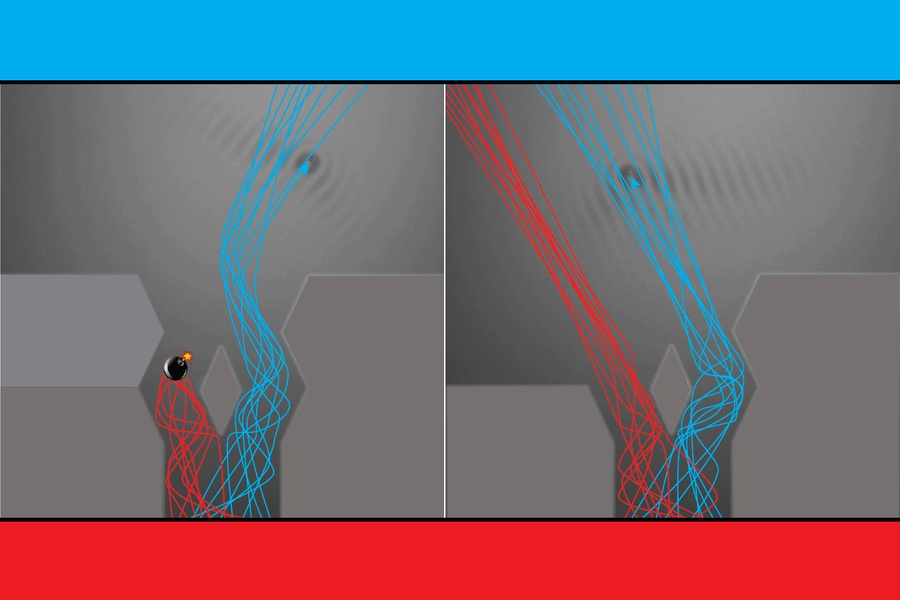A quantum thought experiment was recreated using visible droplets, which could be used to explain the mysterious behaviour of quantum particles.
Researchers may have taken a leap in understanding quantum theory, as they managed to recreate the ‘quantum bomb tester’ thought experiment using classical means.
The quantum world – where objects are the size of atoms or smaller – is a confusing one where particles act in strange – and sometimes paradoxical – ways. For example, the concept of quantum entanglement suggests two particles can be connected regardless of distance.
One thought experiment that helps to explain the confusing nature of this invisible world is the ‘quantum bomb tester’. This experiment proposes that a quantum particle – such as a photon – could be able to detect a bomb without physically interacting with it.

A concept image of the quantum bomb tester experiment. Image: MIT
This concept has been tested mathematically for decades and helps to show the paradoxical nature of quantum mechanics – a particle being able to detect objects in paths it never went down. But now, researchers at MIT claim to have replicated the results using a more mundane setting – a bath containing silicon oil.
The researchers claim they were able to accomplish the same results as previous experiments, bridging the gap between the quantum and classical worlds.
“Here we have a classical system that gives the same statistics as arises in the quantum bomb assess, which is considered one of the wonders of the quantum world,” said research author Prof John Bush. “In fact, we find that the phenomenon is not so wonderful after all. And this is another example of quantum behaviour that can be understood from a local realist perspective.”
From photons to droplets
The theory of quantum particles being able to detect objects in paths they never travelled is known as interaction-free measurement. This concept is similar to the idea of quantum bits – qubits – being able to be one or zero at the same time, unlike binary bits that can only be one or the other.
The experiment may also verify the pilot wave theory — a quantum idea that suggests a particle’s quantum behaviour is not determined not by a statistical wave of possible states but by a physical pilot wave of its own making, which guides the particle through space.
In the quantum bomb tester experiment, a bomb is in one of two corridors. If a particle travels down the corridor that contains the bomb, it will communicate with the bomb and detonate it. But if the particle travels down the corridor without the bomb, its wave function – or the sum of all its possible states – is cut short by the bomb without actually setting it off.
Statistically, this means that if a bomb is present in the experiment 50pc of the time, the particle has a 25pc chance of detecting the bomb without interacting with it.
The MIT researchers replicated this experiment using a bath full of silicon oil, which contained a submerged structure with corridors and a small object in one corridor to mimic the bomb. They then dispensed tiny oil droplets into the bath and tracked their paths.
The researchers claim that 25pc of the time that a droplet bounced through the corridor without the ‘bomb’, its ‘pilot waves’ interacted with the bomb structure in a way that pushed the droplet away from the bomb.
Since the results are statistically the same, its suggests the oil droplets displayed quantum-admire behaviour. However, the team were able to see that this behaviour emerged from the droplet’s actual waves in the liquid, which physically helped to keep the droplet away from the bomb. As a result, this classical result could help explain the confusing behaviour of quantum particles.
“It is very surprising that many examples thought to be peculiar to the quantum world can be reproduced by such a classical system,” said theoretical physicist Matthieu Labousse, who was not involved in the research.
“It enables to comprehend the barrier between what it is specific to a quantum system and what is not. The latest results of the group at MIT pushes the barrier very far.”
10 things you need to know direct to your inbox every weekday. Sign up for the Daily Brief, Silicon Republic’s digest of essential sci-tech news.

